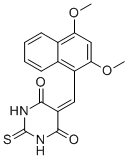
IT-901
CAS No. 1584121-99-2
IT-901( IT 901 | IT901 )
Catalog No. M12262 CAS No. 1584121-99-2
IT-901 is a novel potent, small molecule inhibitor of NF-κB subunit c-Rel.
Purity : >98% (HPLC)
 COA
COA
 Datasheet
Datasheet
 HNMR
HNMR
 HPLC
HPLC
 MSDS
MSDS
 Handing Instructions
Handing Instructions
| Size | Price / USD | Stock | Quantity |
| 5MG | 110 | Get Quote |


|
| 50MG | 597 | Get Quote |


|
| 100MG | 954 | Get Quote |


|
| 200MG | Get Quote | Get Quote |


|
| 500MG | Get Quote | Get Quote |


|
| 1G | Get Quote | Get Quote |


|
Biological Information
-
Product NameIT-901
-
NoteResearch use only, not for human use.
-
Brief DescriptionIT-901 is a novel potent, small molecule inhibitor of NF-κB subunit c-Rel.
-
DescriptionIT-901 is a novel potent, small molecule inhibitor of NF-κB subunit c-Rel, inhibits DNA binding of c-Rel and NF-κB activity with IC50 of 3 uM; reduces stimulation of the oxidative stress response gene heme oxygenase-1, inhibits c-Rel/NF-κB both in vitro and in vivo.
-
In VitroIT-901 (1, 3, 5 μM; for 24 hours) results in decreased proliferation of viable ABC and GCB DLBCL cells. IT-901 (3 μM; for 24 hours) decreases cell viability in a dose-dependent fashion, at least 60 percent of cells were still viable after 48 hours of IT-901 treatment (4μM) in all tested cell lines except HBL1. IT-901 (1, 5, 10 μM; for 6 hours) documents Diminished expression of p65 and p50 in nuclear and cytosolic fractions and also decreases the expression of the inhibitory subunit IκBα both in the phosphorylated and non-phosphorylated forms in primary CLL cells and cell lines. The IC50 of IT-901/GDM-12 is 2.9 μM for c-Rel whereas IL-2 secretion is successfully blocked at 5 μM. The concentrations of IT-901 above 10 μM become increasingly toxic and may lead to apoptosis of healthy cells. IT-901 inhibits cell growth of both activated B-like (ABC) and germinal center B-like (GCB) cell lines with the IC50 values between 3μM to 4μM. Cell Proliferation Assay Cell Line:TMD8 and SU-DHL8 cells Concentration:1, 3, 5 μM.Incubation Time:For 24 hours Result:Resulted in decreased proliferation of viable ABC and GCB DLBCL cells.Cell Viability Assay Cell Line:SU-DHL8 and TMD8 cells.Concentration:3 μM Incubation Time:For 24 hours Result:Decreased cell viability in a dose-dependent fashion.Western Blot Analysis Cell Line:Primary chronic lymphocytic leukemia (CLL) cells and cell lines.Concentration:1, 5, 10 μM.Incubation Time:For 6 hours Result:Documented Diminished expression of p65 and p50 in nuclear and cytosolic fractions and also decreased the expression of the inhibitory subunit IκBα both in the phosphorylated and non-phosphorylated forms.
-
In VivoIT-901 (24 mg/kg; IP; every other day for 2 weeks) has an effective treatment of acute GVHD without impairing anti-tumor activity. IT-901 (12-20 mg/kg; IP) improves the PK profile by increasing T1/2 and Cmax. Animal Model:BALB/C-Tg (NFkB-RE-luc)-Xen mice with 6-9 weeks old Dosage:24 mg/kg Administration:IP; every other day for 2 weeks Result:Had an effective treatment of acute GVHD without impairing anti-tumor activity.
-
SynonymsIT 901 | IT901
-
PathwayApoptosis
-
TargetNF-κB
-
RecptorNF-κB
-
Research Area——
-
Indication——
Chemical Information
-
CAS Number1584121-99-2
-
Formula Weight342.37
-
Molecular FormulaC17H14N2O4S
-
Purity>98% (HPLC)
-
SolubilityIn Vitro:?DMSO : 12.5 mg/mL (36.51 mM)
-
SMILESO=C(/C(C(N1)=O)=C\C2=C3C=CC=CC3=C(OC)C=C2OC)NC1=S
-
Chemical Name5-[(2,4-dimethoxy-1-naphthalenyl)methylene]dihydro-2-thioxo-4,6(1H,5H)-pyrimidinedione
Shipping & Storage Information
-
Storage(-20℃)
-
ShippingWith Ice Pack
-
Stability≥ 2 years
Reference
1. Shono Y, et al. Cancer Res. 2016 Jan 15;76(2):377-89.
molnova catalog



related products
-
Edasalonexent
Edasalonexent (CAT-1004) is a bifunctional, orally administered small molecule that covalently links 2 compounds known to inhibit NF‐κB, salicylic acid and docosahexaenoic acid (DHA).
-
Anti-inflammatory ag...
Anti-inflammatory agent 51 is an amide/sulfonamide derivative with anti-inflammatory and potentially anti-tumor activity and inhibition of NF-κB activation, which can be used to study acute lung injury and ulcerative colitis.
-
Ergolide
Ergolide inhibits inducible nitric oxide synthase and cyclo-oxygenase-2 expression in RAW 264.7 macrophages through the inactivation of NF-κB.?



 Cart
Cart
 sales@molnova.com
sales@molnova.com


